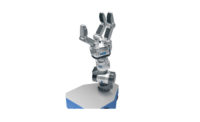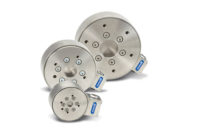However, pausing to swap grippers is unproductive, and storing multiple sets of grippers on the line takes up valuable floor space.
This issue is particularly acute in the automotive industry, where more and more OEMs and suppliers are moving towards universal plants and flexible assembly lines. As model variety increases, engines and other components can only be produced profitably if automated assembly lines can be changed over in a short time.
Multifunctional servo-driven grippers, which can handle a variety of parts in alternating succession, are one solution to the problem. For example, flexible servo-driven grippers are available for handling crankshafts, cylinder heads or motor blocks. A special gripper equipped with a compensation unit can handle four types of cylinder heads weighing up to 95 kilograms. The compensation unit rests on a floating bearing and is then locked eccentrically. A stroke of 342 millimeters enables the gripper to pick up components of different sizes. The compact gripper integrates with the existing robot controller and does not require an additional control unit or regulator.
Flexible grippers for automotive welding lines are more complex. For reliable handling, numerous factors have to be considered, such as the variety of part sizes; the varying surfaces and positions of gripping points; and the forces and vibrations affecting the gripper. Ideally, the parts and assembly line should be designed at the same time. For example, when designing parts, engineers should try to identify identical clamping and gripping points.
Lightweight Grippers
A robotic cell for automotive side sills provides an idea of what a flexible clamping and gripping system for vehicle assembly might look like. The cell was jointly developed by SCHUNK, FANUC Robotics and systems integrator FFT EDAG. The cell consists of one six-axis robot for assembly and an additional six-axis robot that acts as a flexible clamping device.
The latter is equipped with a SCHUNK LEG long-stroke electric gripper. The standardized, modular gripper weighs 8.8 kilograms, grips with a maximum force of 1,140 newtons, and provides a stroke length from 0 and 568 millimeters. For this application, it was equipped with a servo-electric drive from FANUC. Thanks to plug-and-play connectivity, the gripper works like another robot axis and can be actuated with the same instruction set.
Two degrees of freedom at the gripper, five at the device, and six at the robot open up a new spectrum of possibilities for assembly.
To save more weight in end-of-arm tooling, grippers can be made from composites. For example, SCHUNK offers a long-stroke gripper, the LEG-C, made of a carbon-fiber composite with a scalable pneumatic drive. At a weight of 10 kilograms, the LEG-C provides a maximum gripping force of 4,000 newtons and a variable stroke of up to 600 millimeters.
If shortened finger travels are required, the stroke can be individually scaled. This minimizes cycle times and reduces compressed-air consumption, which makes the gripper much more efficient. The gripper’s aluminum fingers are also executed in a lightweight design. They travel on recirculating ball-bearing carriages.
The gripper can be exactly adjusted to the individual payload. In case of particularly high gripping forces or extremely long fingers, the distance between the carriages can be enlarged. This way, even fingers with a length of more than 1,000 millimeters can be used. The belt drive and the synchronized fingers ensure that the gripper works precisely at variable strokes. This is ideal when large and small parts have to be alternately handled.
In addition to flexibility, lightweight servo-driven grippers are also more energy-efficient.
Gripper Lends a Hand
For gripping a wide variety of small components, the human hand is surely the best template. The SDH-2 three-finger gripper was designed to mimic the ability of the human hand. With its seven independent degrees of freedom, it can grip and position various objects without any setup. A tactile sensor system safely and sensitively monitors the optimum grip and supplies information to the control unit to make gripping corrections if necessary. This enables even difficult geometries to be reliably handled, positioned and inserted. The gripper is also protected against dust and humidity.
In the future, the automotive industry will have highly flexible manufacturing plants that do not need rigidly defined tools, devices or grippers. Sensor-equipped, servo-driven gripping and handling systems will be the linchpin of these new plants.







